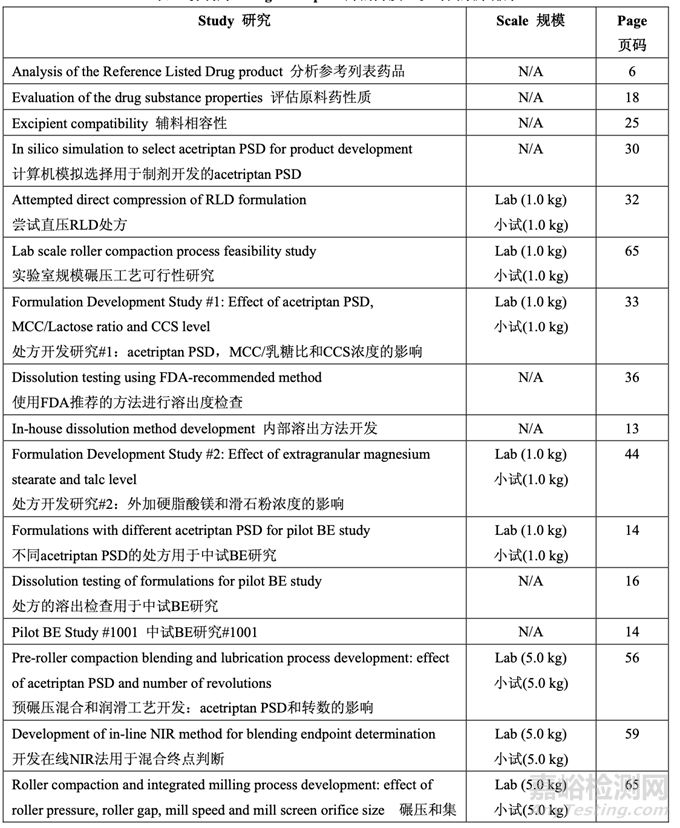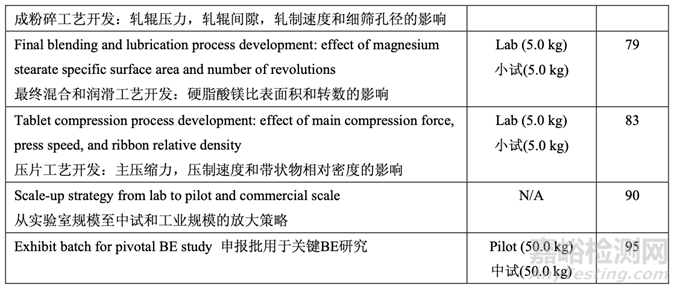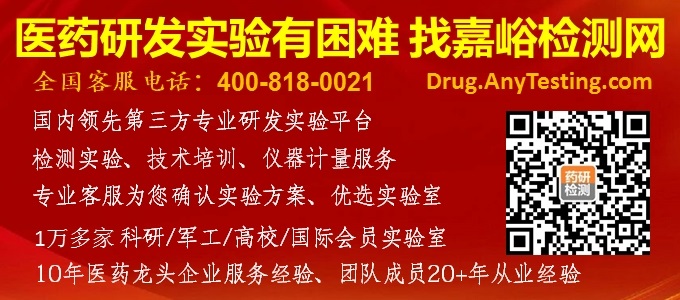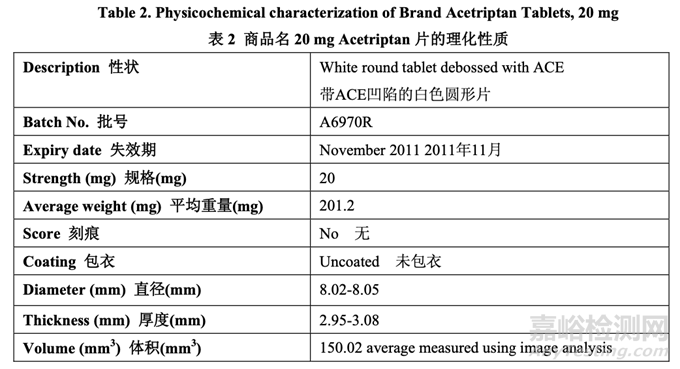This is an example pharmaceutical development report illustrating how ANDA applicants can move toward implementation of Quality by Design (QbD). The purpose of the example is to illustrate the types of pharmaceutical development studies ANDA applicants may use as they implement QbD in their generic product development and to promote discussion on how OGD would use this information in review.
FDA官网中一个有关药物开发报告的实例,用以说明ANDA申请人如何实施质量源于设计(QbD)。 该实例的目的是说明申请人在其仿制药开发过程中实施QbD时,可使用的药物开发研究的类型,同时促进探讨OGD在审评中如何使用该信息。
本文主要概述和分析了参与制剂,包括参比制剂的临床、药动学、药物释放、理化性质和组分,为药物进一步开发积累认知。
1.1 Executive Summary 概述
The following pharmaceutical development report summarizes the development of Generic Acetriptan Tablets, 20 mg, a generic version of the reference listed drug (RLD), Brand Acetriptan Tablets, 20 mg. The RLD is an immediate release (IR) tablet indicated for the relief of moderate to severe physiological symptoms. We used Quality by Design (QbD) to develop generic acetriptan IR tablets that are therapeutically equivalent to the RLD.
总结了如下药物开发报告,开发 20 mg Acetriptan 片的仿制药,一种商品名 20 mg Acetriptan 片的参考目录药物(RLD)的仿制药。RLD 为速释(IR)片,用于缓解中度至重度生理症状。使用质量源于设计(QbD)法用以开发与 RLD 治疗等效的 acetriptan IR 片的仿制药。
Initially, the quality target product profile (QTPP) was defined based on the properties of the drug substance, characterization of the RLD product, and consideration of the RLD label and intended patient population. Identification of critical quality attributes (CQAs) was based on the severity of harm to a patient (safety and efficacy) resulting from failure to meet that quality attribute of the drug product. Our investigation during pharmaceutical development focused on those CQAs that could be impacted by a realistic change to the drug product formulation or manufacturing process. For generic acetriptan tablets, these CQAs included assay, content uniformity, dissolution and degradation products.
明确目标药品的质量概况(QTPP)是根据原料药的性质,RLD 产品的特性,并考虑到 RLD 标签和预定患者人群。关键质量属性(CQAs)的确定是基于由于不符合药品的质量属性而对患者造成的伤害严重性(安全性和有效性)。在药物开发中研究集中在那些可能受制剂处方或生产工艺的实际变动而受到影响的CQAs。对 acetriptan 片的仿制药,这些 CQAs 包括含量,含量均匀度,溶出和降解物。
Acetriptan is a poorly soluble, highly permeable Biopharmaceutics Classification System (BCS) Class II compound. As such, initial efforts focused on developing a dissolution method that would be able to predict in vivo performance. The developed in-house dissolution method uses 900 mL of 0.1 N HCl with 1.0% w/v sodium lauryl sulfate (SLS) in USP apparatus 2 stirred at 75 rpm. This method is capable of differentiating between formulations manufactured using different acetriptan particle size distributions (PSD) and predicting their in vivo performance in the pilot bioequivalence (BE) study.
Acetriptan为难溶,高渗透生物药剂分类系统(BCS)II类化合物。因此,初始工作集中于开发一种可预测体内性能的溶出方法。开发的溶出方法为在75rpm转速的USP装置2中,使用900 mL含1.0% w/v十二烷基硫酸钠(SLS)的0.1 N HCl溶液。该方法能区分使用不同 acetriptan粒度分布(PSD)生产的处方并预测其在中试生物等效性(BE)研究中的体内性能。
Risk assessment was used throughout development to identify potentially high risk formulation and process variables and to determine which studies were necessary to achieve product and process understanding in order to develop a control strategy. Each risk assessment was then updated after development to capture the reduced level of risk based on our improved product and process understanding.
在整个开发中使用风险评估以确认潜在的高风险处方和工艺变量,并确定哪些研究是必须的以达到对产品和工艺的理解以便开发一种控制策略。然后基于我们对产品和工艺改进的理 解,在开发后更新每个风险评估以获得降低的风险水平。
For formulation development, an in silico simulation was conducted to evaluate the potential effect of acetriptan PSD on in vivo performance and a d90 of 30 μm or less was selected. Roller compaction (RC) was selected as the granulation method due to the potential for thermal degradation of acetriptan during the drying step of a wet granulation process. The same types of excipients as the RLD product were chosen. Excipient grade selection was based on experience with previously approved ANDA 123456 and ANDA 456123 which both used roller compaction. Initial excipient binary mixture compatibility studies identified a potential interaction between acetriptan and magnesium stearate. However, at levels representative of the final formulation, the interaction was found to be negligible. Furthermore, the potential interaction between acetriptan and magnesium stearate is limited by only including extragranular magnesium stearate.
对于处方开发,进行计算机模拟以评估acetriptan PSD对体内性能的潜在影响,选择了d90为30 μm或低于30 μm。选择碾压(RC)作为制粒方法由于acetriptan在湿法制粒工艺的干燥步骤中可能发生热降解。选择与RLD产品相同类型的辅料,辅料级别的选择是基于先前批准的 ANDA 123456和ANDA 456123都使用碾压的经验。初始辅料二元混合物相容性研究确认 acetriptan和硬脂酸镁间有潜在相互作用。但是,在表示最终处方的浓度下,发现该相互作用可忽略不计。此外,acetriptan和硬脂酸镁间的潜在相互作用受仅包括外加硬脂酸镁的限制。
Two formulation development design of experiments (DOE) were conducted. The first DOE investigated the impact of acetriptan PSD and levels of intragranular lactose, microcrystalline cellulose and croscarmellose sodium on drug product CQAs. The second DOE studied the levels of extragranular talc and magnesium stearate on drug product CQAs. The formulation composition was finalized based on the knowledge gained from these two DOE studies.
进行了两个处方开发实验设计(DOE)。第一个DOE研究了acetriptan PSD和外加乳糖,微晶纤维素和交联羧甲基纤维素钠的浓度对制剂CQAs的影响。第二个DOE研究了外加滑石粉和硬脂酸镁的浓度对制剂CQAs的影响。基于这两个DOE研究所得的知识,确定了处方成分。
An in-line near infrared (NIR) spectrophotometric method was validated and implemented to monitor blend uniformity and to reduce the risk associated with the pre-roller compaction blending and lubrication step. Roller pressure, roller gap and mill screen orifice size were identified as critical process parameters (CPPs) for the roller compaction and integrated milling process step and acceptable ranges were identified through the DOE. Within the ranges studied during development of the final blending and lubrication step, magnesium stearate specific surface area (5.8-10.4 m2/g) and number of revolutions (60-100) did not impact the final product CQAs. During tablet compression, an acceptable range for compression force was identified and force adjustments should be made to accommodate the ribbon relative density (0.68-0.81) variations between batches in order to achieve optimal hardness and dissolution.
验证了在线近红外(NIR)分光光度法并用于监测混合均匀度和降低与预碾压混合和润滑步骤相关的风险。轧辊压力,轧辊间隙和细筛孔径确定为碾压和集成粉碎工艺步骤的关键工艺参数(CPPs)并通过DOE确定了可接受范围。在开发最终混合和润滑步骤中的研究范围内,硬脂酸镁比表面积(5.8~10.4 m2/g)和转数(60~100)不影响最终产品CQAs。在压片中,确定了可接受范围的压缩力并应调整压缩力以容纳批次间带状物相对密度(0.68~0.81)的变化以便达 到硬度和溶出的最优化。
Scale-up principles and plans were discussed for scaling up from lab (5.0 kg) to pilot scale (50.0 kg) and then proposed for commercial scale (150.0 kg). A 50.0 kg cGMP exhibit batch was manufactured at pilot scale and demonstrated bioequivalence in the pivotal BE study. The operating ranges for identified CPPs at commercial scale were proposed and will be qualified and continually verified during routine commercial manufacture.
讨论了从实验室规模(5.0 kg)放大至中试规模(50.0 kg)的放大原则和计划,然后拟定了工业规 模(150.0 kg)。在中试规模下生产了50.0 kg cGMP申报批并在关键BE研究中显示生物等效。工业规模下,拟定了已确认的CPPs操作范围,在常规工艺生产中将进行限定并持续验证。
Finally, we proposed a control strategy that includes the material attributes and process parameters identified as potentially high risk variables during the initial risk assessments. Our control strategy also includes in-process controls and finished product specifications. The process will bemonitored during the lifecycle of the product and additional knowledge gained will be utilized to make adjustments to the control strategy as appropriate.
最后,我们提出了控制策略,包括初始风险评估中确认为潜在高风险变量的物质属性和工艺参数。将在产品的生命周期中监测工艺并且获得的额外知识将用于对控制策略的适当调整。
The development time line for Generic Acetriptan Tablets, 20 mg, is presented in Table 1.
仿制药 20 mg Acetriptan 片的开发时间线列于表 1。
Table 1. Development of Generic Acetriptan Tablets, 20 mg, presented in chronological order
表 1 仿制药 20 mg Acetriptan 片的开发,以时间顺序排序

1.2 Analysis of the Reference Listed Drug Product 分析参比制剂
1.2.1 Clinical 临床
The Reference Listed Drug (RLD) is Brand Acetriptan Tablets, 20 mg, and was approved in the United States in 2000 (NDA 211168) for therapeutic relief of moderate to severe symptoms. The RLD is an unscored immediate release (IR) tablet with no cosmetic coating. The tablet needs to be swallowed “as is” without any intervention. Thus, the proposed generic product will also be an unscored IR tablet with no cosmetic coating. The maximum daily dose in the label is 40 mg (i.e., one tablet twice per day). A single tablet is taken per dose with or without food. Brand Acetriptan Tablets, 20 mg, should be swallowed whole with a glass of water.
参比药品(RLD)为商品名20 mg Acetriptan片,于2000年在美国批准(NDA 211168)用于治疗缓解中度至重度症状。RLD为无刻痕非包衣的速释(IR)片。需“依现状”吞下片剂而无任何 干预。因此,拟定仿制药也是为无刻痕非包衣IR片。标签中的最大日剂量为40 mg (即一日 两次,每次一片)。单位剂量的单片可与食物或不与食物服用。商品名20 mg Acetriptan片, 应用一杯水整片吞服。
1.2.2 Pharmacokinetics 药动学
Acetriptan is well absorbed after oral administration. The median Tmax is 2.5 hours (h) in patients. The mean absolute bioavailability of acetriptan is approximately 40%. The AUC and Cmax of acetriptan are increased by approximately 8% to 12% following oral dosing with a high fat meal. The terminal elimination half-life of acetriptan is approximately 4 hours.
Acetriptan口服后吸收良好。患者的平均Tmax为2.5小时。Acetriptan的平均绝对生物利用度约 40%。与高脂肪饮食一起服用后,acetriptan的AUC和Cmax增加了约8%~12%。Acetriptan的 末端消除半衰期约4小时。
1.2.3 Drug Release 药物释放
Drug release is usually the rate limiting process for absorption of a Biopharmaceutics Classification System (BCS) Class II compound like acetriptan due to its low solubility. Therefore, the dissolution of the RLD tablets was thoroughly evaluated. Initially, the dissolution method recommended in the FDA dissolution methods database for this product was utilized (900 mL of 0.1 N HCl with 2.0% w/v sodium lauryl sulfate (SLS) using USP apparatus 2 (paddle) at 75 rpm). The temperature of the dissolution medium was maintained at 37 ± 0.5 °C and the drug concentration was determined using UV spectroscopy at a wavelength of 282 nm. The drug release of RLD tablets was also obtained at different medium pH (pH 4.5 acetate buffer and pH 6.8 phosphate buffer) with 2.0% w/v SLS. As shown in Figure 1, RLD tablets exhibited a very rapid dissolution using the FDA-recommended method without any sensitivity to medium pH.
对于像acetriptan的生物药学分类系统(BCS) II类化合物的吸收,由于其低溶解度,药物释放通常是速率限制过程。因此,应彻底评估 RLD 片剂的溶出。开始,使用该产品在 FDA 溶出方法数据库中推荐的溶出方法(用 USP 装置 2(桨法),转速为 75 rpm,900 mL 含 2.0% w/v 十二烷基硫酸钠(SLS) 的 0.1 N HCl 溶出介质)。溶出介质的温度维持在 37 ± 0.5 °C,用 UV 分光光度法在 282 nm 波长处测定药物浓度。也得到了在含 2.0% w/v SLS 的不同 pH 值 (pH 4.5 醋酸缓冲液和 pH 6.8 磷酸缓冲液)溶出介质的 RLD 片剂的药物释放。如图 1 所示,使用 FDA 推荐的方法,RLD 片剂显示出快速溶出,对介质 pH 值不敏感。
1.2.4 Physicochemical Characterization 理化性质
The physicochemical characterization of the RLD tablet is summarized in Table 2. Characterization included determination of the level of ACE12345, a known degradant, in near expiry product.
RLD 片的理化性质概述在表 2 中。性质包括了测定 ACE12345,一种已知降解物,在临失效 产品中的浓度。
1.2.5 Composition 组分
Based on the RLD labeling, patent literature and reverse engineering, Table 3 lists the composition of Brand Acetriptan Tablets, 20 mg. The level provided for each excipient is consistent with previous experience and is below the level listed in the inactive ingredient database (IID) for FDA-approved oral solid dosage forms.
基于 RLD 标签,专利文献和反向工程,表 3 列出了商品名 20 mg Acetriptan 片的组分。每个辅料提供的浓度与之前的经验一致,低于 FDA 批准的口服固体制剂非活性成分数据库(IID) 所列出的浓度。
参考文献:
Example QbD IR Tablet Module 3 Quality 3.2.P.2 Pharmaceutical Development,FDA,2012.










